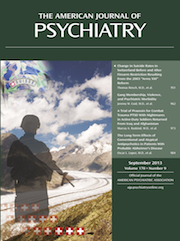It has long been recognized that current classifications of disorders associated with psychosis, notably schizophrenia, bipolar disorder, delusional disorder, and schizoaffective disorder, will be reformulated when their pathophysiological etiology is identified. The modest progress made to date has not been sufficient to redefine the classification landscape based on neurobiology, biomarkers, or distinctive phenomenology. One winces when an overlap is claimed based on similar ratings on a particular test at a single assessment, because this simplistic analysis overlooks the remarkable distinctions in form and content between these disorders. The DSM-5 Psychosis Work Group made moderate progress with the reconceptualization of schizoaffective disorder as a lifetime of mixed affective and psychotic features rather than permitting the diagnosis after a single mixed episode.
Other improvements for DSM-5 have also attempted to make diagnostic boundaries clearer based on comorbidity. Body dysmorphic and obsessive-compulsive disorders with delusions no longer require delusional disorder as a comorbidity because the delusions have lifetime histories and treatment responses that differ from delusional disorder, with which they were formerly classified. Delusional disorder itself no longer requires that the delusion be labeled nonbizarre, since that distinction between delusional disorder and schizophrenia was uncertain. Similarly, schizophrenia can no longer be diagnosed solely by the presence of a bizarre delusion. This corrects a mistaken primacy assigned to Schneiderian first-rank symptoms in DSM-III and DSM-IV.
Every clinician knows that within any diagnosis, including the psychoses, individual patients appear quite different. While research rating scales can capture these variations, clinicians who treat psychotic disorders have not adopted these scales in the way that those who treat depression made the Hamilton and Beck scales commonplace tools. Eight dimensions can now be rated, either by clinicians or clinical researchers, from absent to severe on a simple 0–4 scale: delusions, hallucinations, disorganized thinking, negative symptoms, psychomotor symptoms, cognition, depression, and mania. The Psychosis Work Group believes that these domains of pathology, now in Section 3 of DSM-5 (“Conditions for Further Study”), are essential to evaluate patients, address treatment, and relate psychopathology to identified behavioral constructs. In the future, these domains may provide a bridge to National Institute of Mental Health research in the Research Domain Criteria framework. We believe that new therapies targeting one or more of these domains specifically, in the context of the life course of a patient’s illness, will someday by approved by the Food and Drug Administration and other regulatory bodies.
The feature of the life course of patients with psychoses that was most contentious, but that was also widely recognized to be the most important, was the development of schizophrenia and other psychoses during adolescence and early adulthood. Knowledge developed in the past 20 years regarding the association between at-risk mental states and substantially increased risk for later progression to schizophrenia has culminated in a validated case identification methodology that positions clinical care to address current needs as well as secondary prevention of psychotic illness. A remarkable initial report of effectiveness of 12 weeks of 3-omega free fatty acids in preventing the development of psychosis over the following 40 weeks (
1) illustrates this potential for early intervention that may alter the life course.
It seems likely that the risk concept will be broadened in two ways. First, risk for psychosis development may be divided into two stages: very early detection before the onset of distress or dysfunction meriting clinical care and a second stage when distress or dysfunction require clinical attention but full psychosis has not developed. The first provides a risk paradigm with implications for primary prevention and the second a disorder where clinical care addresses the present disorder but may also involve secondary prevention of psychosis.
The second broadening will be based on moving from the schizophrenia prodrome construct to a definition of risk for psychosis development that includes risk for major depression and bipolar disorders with psychosis and perhaps an even broader range of disorders associated with psychosis. Current research is not exclusive to schizophrenia risk, but it is skewed in that direction. Aspects of the development of full psychosis are likely to be shared across a number of disorders.
Some of the Work Group members advocate creating a classification for individuals manifesting current psychopathology that places them at high risk for further development of a disorder with psychosis. Whether this will be within the schizophrenia spectrum, as presently proposed in Section 3 based on current data, or more broadly placed as risk for other disorders with psychotic features will be determined as further knowledge of early identification and risk status is developed outside of the schizophrenia prodrome construct.
Thus, the Work Group began its task by clarifying the boundaries between diagnoses, a process begun with DSM-III, and ended by proposing a future dimensional approach, which ignores such boundaries, particularly during the early development of illnesses when much is unclear. This effort will be in the service of ultimately discovering the causes and developing new therapeutic options for these patients.

